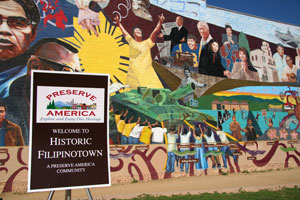Fil-Ams help Los Angeles survey ethnic community landmarks
LOS ANGELES – This city boasts a rich history of Filipino presence and impact on Angeleno culture.
Filipinos started immigrating to the U.S. since the early 1900s, many of them eventually settling in the LA area.
Currently, LA is home to the largest population of Filipinos outside of the Philippines, with more than 374,000 Filipinos residing in the LA County, according to the 2010 census.
To record the city’s cultural history, the City of LA Office of Historic Resources (OHR) and the Architectural Resources Group (ARG) SurveyLA have begun collecting more information from five of the city’s Asian American communities: Chinese American; Filipino American; Japanese American; Korean American and Thai American.
With this information, the city plans to establish “historic context” documents that will provide identification of sites that are culturally significant to these Asian groups.
Towards a national register
The OHR was awarded a $72,000 Underrepresented Communities Grant by the National Parks Service (NPS) to conduct the wide-ranging project. The city is looking to produce these historic context statements to develop a national register nomination to the NPS.
With the help of the Filipino American community, the city wants to identify historically significant neighborhoods, commercial areas, residences among other landmarks that are still standing today and had been utilized by the community between 1900 to 1980.
While Historic Filipinotown is the geographically designated center for Filipinos, the city is looking for historically significant businesses, organizations, trends, activities, movements and people in all areas of LA, explained Jan Zatorski, deputy director of the Department of City Planning, at a community forum for Fil-Ams.
Filipino Americans from business, religious institutions, community organizations and the arts gathered at the Edendale Branch Library on Saturday, April 8 to learn more about the project, as well as to provide information for the project organizers and consultants.
Themes
The following “themes” need to be addressed: civil rights and civil liberties, commercial development, cultural development and institutions, deed restriction and segregation, labor history, religion and spirituality and social clubs and organizations.
Long-time Westlake resident Ronald Bonilla applauded the city for taking a step toward recognizing the Filipino influence on the city.
“I don’t think many people realize how impactful Filipinos were and are in Los Angeles, and it’s nice to see [the city] make some kind of account of our history here,” Bonilla, 45, told the Asian Journal.
Bonilla is a native Angeleno and second-generation Filipino American. He worries that the “influx of gentrifiers” in the city will wash away much of its ethnic heritages; but he hopes that this project will help solidify and strengthen cultural ties.
“I hope that this will bring more recognition and attention to, not just Filipinos here, but to Asian Americans in general,” Bonilla added. “Gentrification is a big problem, but it’s not a problem without a solution.”


